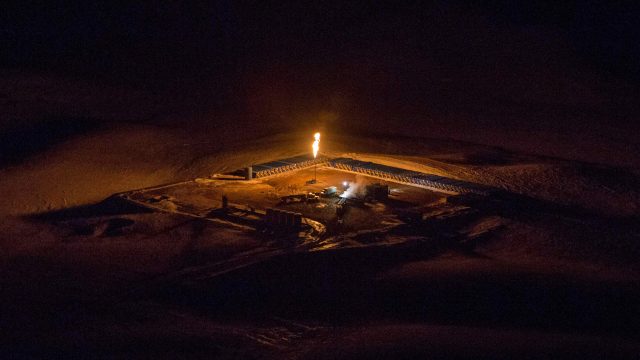Flaring In North Dakota Is Lower On Land Regulated By State Instead Of Feds

Nobody likes the fact that so much natural gas is burned off in western North Dakota rather than captured, sold, and used. The gas is a valuable commodity, and for reasons both environmental and economic, it shouldn’t just be burned up if it can be avoided.
There is progress being made. The amount of gas captured in North Dakota is up 135 percent since 2011, and the percentage of gas flared is down. Plus, the oil industry is implementing a plan (they just got approval from the North Dakota Industrial Commission) to decrease flaring to about 10 percent within six years.
Still, in the here and now, there’s a lot of gas being flared. But there’s something interesting about the differential between gas flared on state and private land, and gas flared on federal land. Specifically the Forth Berthold Indian Reservation. According to a recent report from the Williston Herald, flaring is “at nearly 30 percent on private and state lands in North Dakota, with an estimated 40 percent on the Fort Berthold Reservation.”
That jibes with numbers presented by the North Dakota Petroleum Council to the NDIC back in November, showing about 29 percent flaring on state/private lands, but over 40 percent on the reservation (that presentation is embedded below). I’m trying to get numbers for flaring on all federal land in North Dakota, versus flaring on state land, but nobody seems to keep those numbers so I have to build them myself from what’s available publicly.
Still, variance between the reservation and state/private lands is telling. Why is flaring so much higher on the reservation? Most of the problem is government interference, both federal and local.
Right-of-way easements for the infrastructure to gather the gas is harder to get from the tribe, according to Tessa Sandstrom, spokeswoman for the NDPC. Also, the infrastructure gets permit scrutiny from three separate federal agencies: The Bureau of Indian Affairs, the Bureau of Land Management and the US Fish & Wildlife Service. There is also a tribal requirement for a half-mile setback for all pipelines and condensers from any occupied structure.
Now, the tribe is certainly free to set any policy they wish, but very often State of North Dakota officials get criticism for regulating oil and gas development too lightly. But the difference between flaring on federal land and state/private land speaks to the unintended consequences of regulating with a heavy hand.
We could be flaring a lot less natural gas in North Dakota, which is something everybody wants, if it weren’t for the federal government and its byzantine regulations.




